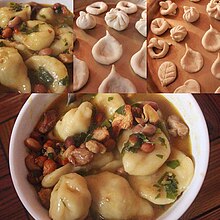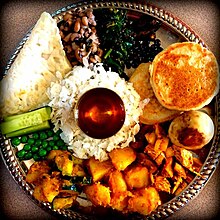
Polish cuisine is a style of cooking and food preparation originating in or widely popular in Poland. Due to Poland's history, Polish cuisine has evolved over the centuries to be very eclectic, and it shares many similarities with other regional cuisines. Polish-styled cooking in other cultures is often referred to as à la polonaise.

Momo is a type of steamed filled dumpling with origins from Tibet. It is also popular in Bhutan, Nepal and in the Indian region of Ladakh and the state of Sikkim. In Nepal, where it is considered a national dish, they are usually served with a sauce known as achar influenced by the spices and herbs used within many South Asian cuisines. It can also be cooked as soup versions known as Jhol Momo where the broth is made from achar using a mixture of tomatoes, sesame seeds, chillies, cumin and coriander or Mokthuk from boiling pork/buff bones mixing with various herbs and vegetables.

Korean royal court cuisine was the style of cookery within Korean cuisine traditionally consumed at the court of the Joseon Dynasty, which ruled Korea from 1392 to 1910. There has been a revival of this cookery style in the 21st century. It is said that twelve dishes should be served along with rice and soup, with most dishes served in bangjja (bronzeware).

Singaporean cuisine is derived from several ethnic groups in Singapore and has developed through centuries of political, economic, and social changes in the cosmopolitan city-state.

Penang cuisine is the cuisine of the multicultural society of Penang, Malaysia. Most of these cuisine are sold at road-side stalls, known as "hawker food" and colloquially as "muckan carts". Local Penangites typically find these hawker fares cheaper and easier to eat out at due to the ubiquitousness of the hawker stalls and that they are open for much of the day and night. Penang island. On February 22, 2013, Penang was ranked by CNN Travel as one of the top ten street food cities in Asia. Penang has also been voted by Lonely Planet as the top culinary destination in 2014.

Czech cuisine has both influenced and been influenced by the cuisines of surrounding countries and nations. Many of the cakes and pastries that are popular in Central Europe originated within the Czech lands. Contemporary Czech cuisine is more meat-based than in previous periods; the current abundance of farmable meat has enriched its presence in regional cuisine. Traditionally, meat has been reserved for once-weekly consumption, typically on weekends.

Noodle soup refers to a variety of soups with noodles and other ingredients served in a light broth. Noodle soup is a common dish across East Asia, Southeast Asia and the Himalayan states of South Asia. Various types of noodles are used, such as rice noodles, wheat noodles and egg noodles.

Nepali cuisine comprises a variety of cuisines based upon ethnicity, alluvial soil and climate relating to Nepal's cultural diversity and geography. Dal-bhat-tarkari is eaten throughout Nepal. Dal is a soup made of lentils and spices, bhat — usually rice but sometimes another grain — and a vegetable curry, tarkari. Condiments are usually small amounts of spicy pickle which can be fresh or fermented, mainly of dried mustard greens and radish and of which there are many varieties. Other accompaniments may be sliced lemon (nibuwa) or lime (kagati) with fresh green chilli and a fried papad and also Islamic food items like rice pudding, sewai, biryani etc. Dhindo (ढिंडो) is a traditional food of Nepal. A typical example of Nepali cuisine is the Chaurasi Byanjan(Nepali: चौरासी व्यञ्जन) set where bhat(rice) is served in a giant leaf platter(Patravali) along with 84 different Nepali dishes each served on small plates.It is mostly fed during weddings and Pasni(rice feeding ceremony).

Bhutanese cuisine employs much red rice, buckwheat, and increasingly maize.

Javanese cuisine is the cuisine of Javanese people, a major ethnic group in Indonesia, more precisely the province of Central Java, Yogyakarta and East Java.

Sundanese cuisine is the cuisine of the Sundanese people of Western Java, and Banten, Indonesia. It is one of the most popular foods in Indonesia. Sundanese food is characterised by its freshness; the famous lalab eaten with sambal and also karedok demonstrate the Sundanese fondness for fresh raw vegetables. Unlike the rich and spicy taste, infused with coconut milk and curry of Minangkabau cuisine, the Sundanese cuisine displays the simple and clear taste; ranged from savoury salty, fresh sourness, mild sweetness, to hot and spicy.

Malaysian Indian cuisine, or the cooking of the ethnic Indian communities in Malaysia, consists of adaptations of authentic dishes from India, as well as original creations inspired by the diverse food culture of Malaysia. Because the vast majority of Malaysia's Indian community are of South Indian descent, and are mostly ethnic Tamils who are descendants of immigrants from a historical region which consists of the modern Indian state of Tamil Nadu and Sri Lanka's Northern Province, much of Malaysian Indian cuisine is predominantly South Indian inspired in character and taste. A typical Malaysian Indian dish is likely to be redolent with curry leaves, whole and powdered spice, and contains fresh coconut in various forms. Ghee is still widely used for cooking, although vegetable oils and refined palm oils are now commonplace in home kitchens. Before a meal it is customary to wash hands as cutlery is often not used while eating, with the exception of a serving spoon for each respective dish.

Dumpling is a broad class of dishes that consist of pieces of cooked dough, often wrapped around a filling. The dough can be based on bread, flour, buckwheat or potatoes, and it may be filled with meat, fish, tofu, cheese, vegetables, fruits or sweets. Dumplings may be prepared using a variety of cooking methods and are found in many world cuisines.

Maithil cuisine, also known as Mithila cuisine, is a part of Indian and Nepalese cuisine. It is the traditional cooking style of Maithils residing in the Mithila region of India and Nepal.

Indian Indonesian cuisine is characterized by the mixture of Indian cuisine with local Indonesian-style. This cuisine consists of adaptations of authentic dishes from India, as well as original creations inspired by the diverse food culture of Indonesia. Indian influence can be observed in Indonesia as early as the 4th century. Following the spread of Islam to Indonesia and trading, Muslim Indian as well as Arab influences made their way into Indonesian cuisine. Examples include Indian biryani, murtabak, curry and paratha that influenced Acehnese, Minangkabau, Malay, Palembangese, Betawi and Javanese cuisine.

Indonesian noodles are a significant aspect of Indonesian cuisine which is itself very diverse. Indonesian cuisine recognizes many types of noodles, with each region of the country often developing its own distinct recipes.

























